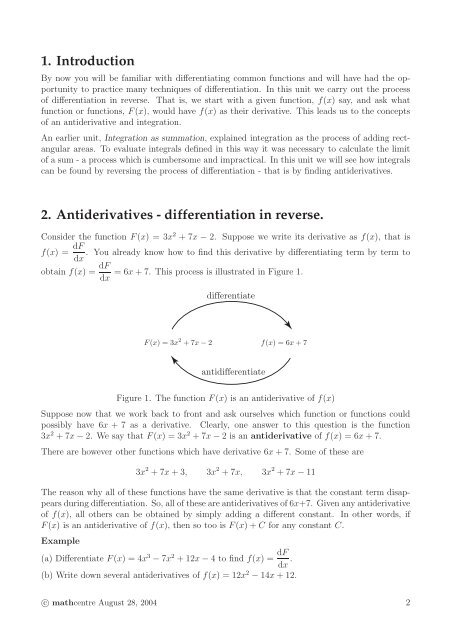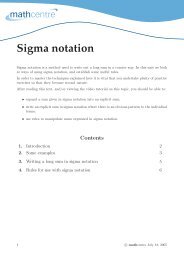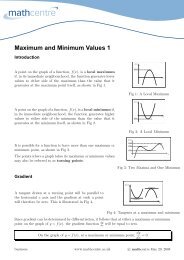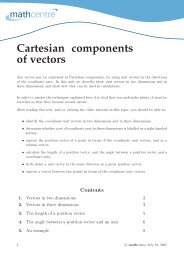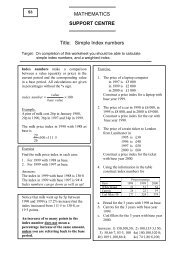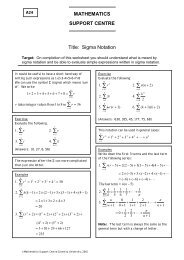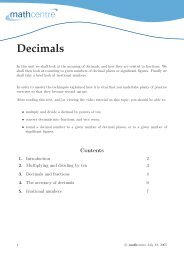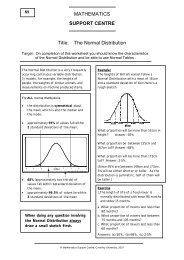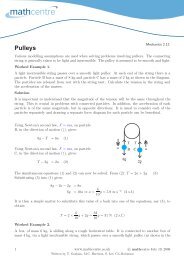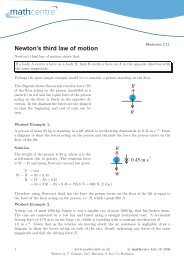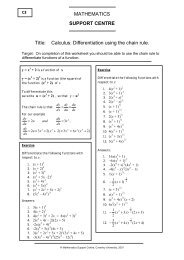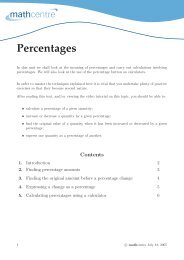indefinite integration as the reverse of differentiation
indefinite integration as the reverse of differentiation
indefinite integration as the reverse of differentiation
Create successful ePaper yourself
Turn your PDF publications into a flip-book with our unique Google optimized e-Paper software.
1. Introduction<br />
By now you will be familiar with differentiating common functions and will have had <strong>the</strong> opportunity<br />
to practice many techniques <strong>of</strong> <strong>differentiation</strong>. In this unit we carry out <strong>the</strong> process<br />
<strong>of</strong> <strong>differentiation</strong> in <strong>reverse</strong>. That is, we start with a given function, f(x) say, and <strong>as</strong>k what<br />
function or functions, F(x), would have f(x) <strong>as</strong> <strong>the</strong>ir derivative. This leads us to <strong>the</strong> concepts<br />
<strong>of</strong> an antiderivative and <strong>integration</strong>.<br />
An earlier unit, Integration <strong>as</strong> summation, explained <strong>integration</strong> <strong>as</strong> <strong>the</strong> process <strong>of</strong> adding rectangular<br />
are<strong>as</strong>. To evaluate integrals defined in this way it w<strong>as</strong> necessary to calculate <strong>the</strong> limit<br />
<strong>of</strong> a sum - a process which is cumbersome and impractical. In this unit we will see how integrals<br />
can be found by reversing <strong>the</strong> process <strong>of</strong> <strong>differentiation</strong> - that is by finding antiderivatives.<br />
2. Antiderivatives <strong>differentiation</strong> in <strong>reverse</strong>.<br />
Consider <strong>the</strong> function F(x) = 3x 2 + 7x − 2. Suppose we write its derivative <strong>as</strong> f(x), that is<br />
f(x) = dF . You already know how to find this derivative by differentiating term by term to<br />
dx<br />
obtain f(x) = dF = 6x + 7. This process is illustrated in Figure 1.<br />
dx<br />
differentiate<br />
F(x) = 3x 2 + 7x − 2 f(x) = 6x + 7<br />
antidifferentiate<br />
Figure 1. The function F(x) is an antiderivative <strong>of</strong> f(x)<br />
Suppose now that we work back to front and <strong>as</strong>k ourselves which function or functions could<br />
possibly have 6x + 7 <strong>as</strong> a derivative. Clearly, one answer to this question is <strong>the</strong> function<br />
3x 2 + 7x − 2. We say that F(x) = 3x 2 + 7x − 2 is an antiderivative <strong>of</strong> f(x) = 6x + 7.<br />
There are however o<strong>the</strong>r functions which have derivative 6x + 7. Some <strong>of</strong> <strong>the</strong>se are<br />
3x 2 + 7x + 3, 3x 2 + 7x, 3x 2 + 7x − 11<br />
The re<strong>as</strong>on why all <strong>of</strong> <strong>the</strong>se functions have <strong>the</strong> same derivative is that <strong>the</strong> constant term disappears<br />
during <strong>differentiation</strong>. So, all <strong>of</strong> <strong>the</strong>se are antiderivatives <strong>of</strong> 6x+7. Given any antiderivative<br />
<strong>of</strong> f(x), all o<strong>the</strong>rs can be obtained by simply adding a different constant. In o<strong>the</strong>r words, if<br />
F(x) is an antiderivative <strong>of</strong> f(x), <strong>the</strong>n so too is F(x) + C for any constant C.<br />
Example<br />
(a) Differentiate F(x) = 4x 3 − 7x 2 + 12x − 4 to find f(x) = dF<br />
dx .<br />
(b) Write down several antiderivatives <strong>of</strong> f(x) = 12x 2 − 14x + 12.<br />
c○ mathcentre August 28, 2004 2


